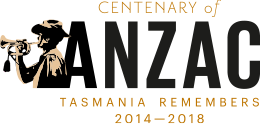- Home
- About
-
History
- Timeline
- Shared stories
- Share your story
- Armistice Centenary
- Tasmania’s Victoria Cross Legacy
- Women and war
- Tasmanian Aboriginal soldiers
- Did you know?
- Caring for military memorabilia, medals and photos
- A guide to preserving Tasmania's war heritage
- 40th Battalion
- 12th Australian Infantry Battalion
- Royal Australian Air Force
- Royal Australian Navy
- Battle of the Somme
- War and sport
- Activities
- Grants and Programs
- News
- Contact
- Home
- About
-
History
- Timeline
- Shared stories
- Share your story
- Armistice Centenary
- Tasmania’s Victoria Cross Legacy
- Women and war
- Tasmanian Aboriginal soldiers
- Did you know?
- Caring for military memorabilia, medals and photos
- A guide to preserving Tasmania's war heritage
- 40th Battalion
- 12th Australian Infantry Battalion
- Royal Australian Air Force
- Royal Australian Navy
- Battle of the Somme
- War and sport
-
Activities
- Calendar of events
- Dig for the Diggers - one act play
- ANZAC Day
- Launch of Tasmania’s Centenary of ANZAC Commemorations
- Remembrance Day
- 10,000 Steps Challenge
- Hartzview marks World War One
- Australian Living Memorials
- Journey Across the Strait
- Lone Pine seedlings
- How Tasmanians commemorated the Centenary
- The Odd Angry Shot
- Grants and Programs
-
News
- Newsletters
- Australian War Dogs
- Students travel to Gallipoli
- ANZACs Remembered – Commemorative Medallion
- ANZAC Day 2021 - Light up the Dawn
- Anzac Day 2021
- A valuable archive of over 130 operational maps
- Ecumenical Church Service
- Simpson Prize
- Our Victoria Cross Heroes book launch
- Nominations open for Tasmanian Honour Roll of Women
- Remembering South Hobart people who served
- Vintage Peace Postcard from 1916 Reprinted
- Sites of Significance Then and Now
- Commemorative Medallion for Second World War veterans
- Victory in Pacific 75th Anniversary
- Public consultation sought for Terms of Reference on Royal Commission
- Contact
- Timeline
- Shared stories
- Share your story
- Armistice Centenary
- Tasmania’s Victoria Cross Legacy
- Women and war
- Tasmanian Aboriginal soldiers
- Did you know?
- Caring for military memorabilia, medals and photos
- A guide to preserving Tasmania's war heritage
- 40th Battalion
- 12th Australian Infantry Battalion
- Royal Australian Air Force
- Royal Australian Navy
- Battle of the Somme
- War and sport
Hudson Fysh
The Spirit of Australia
Experience in aviation gained in World War One helped make Hudson Fysh an aviation visionary.
Aviation was a fledging field in World War One, but it gave Hudson Fysh - an ANZAC veteran who served at Gallipoli in 1915 - the opportunity to spread his wings.
Hudson Fysh was born in Launceston, Tasmania, on 7 January 1895. The 19-year-old wool classer from St Leonards enlisted with the 3rd Light Horse Regiment and embarked from Hobart on the HMAT Geelong A2 on 20 October 1914.
Lieutenant Fysh gained his early flying experience in the Australian Flying Corps as an observer in the Palestine campaign. In 1918, he was heavily involved in actions against German and Turkish aircraft, airfields and ground troops. He shot or forced down a number of enemy aircraft and was awarded the Distinguished Flying Cross.
In 1919, Fysh gained his pilot’s wings in Egypt before returning to Australia. Hudson Fysh and his partners used mainly war disposal aircraft to form the Queensland and Northern Territory Aerial Services Limited (Qantas) in 1920.
During World War Two, Hudson Fysh’s air force and aviation experience played an important role. Under the guidance of Fysh, who was an RAAF Squadron leader, Qantas assisted the war effort by flying long routes, overseeing the use of QEA equipment and expertise against the Japanese, taking troops and equipment to New Guinea, and evacuating casualties.
Hudson Fysh was knighted in 1953.
Sir Hudson Fysh died on the 6 April 1974 in Sydney.
- Photos of Hudson Fysh from the Australian War Memorial. Image numbers P00342.009 and P00342.001




